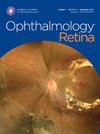Do Treatment Patterns for Endophthalmitis after Cataract Surgery Follow the Endophthalmitis Vitrectomy Study Recommendations?
IF 5.7
Q1 OPHTHALMOLOGY
引用次数: 0
Abstract
Objective
To evaluate whether treatment patterns for endophthalmitis after cataract surgery in American Academy of Ophthalmology IRIS® (Intelligent Research in Sight) Registry patients are in line with evidence-based guidelines established by the 1995 Endophthalmitis Vitrectomy Study (EVS), which showed that patients who present with light perception (LP) vision have better visual outcomes with immediate vitrectomy (VIT) compared with vitreous tap with antibiotic injection (TAP).
Design
Retrospective cohort study.
Subjects
Intelligent Research in Sight Registry patients undergoing cataract surgery between 2014 and 2022 (identified by Current Procedural Terminology codes), presenting with endophthalmitis (identified by International Classification of Diseases 10 codes) within 42 days postcataract surgery, and having a record of being treated with VIT or TAP on the same or 1 day after endophthalmitis diagnosis were identified.
Methods
Potential covariates of age, sex, race, ethnicity, geographic region, insurance status, and visual acuity on the day of endophthalmitis diagnosis were evaluated using multivariable logistic regression.
Main Outcome Measures
Treatment with VIT or TAP.
Results
Of the 2425 patients who met the inclusion criteria, 14% (345) underwent VIT and 86% (2080) underwent TAP. Notably, 80% of patients (1946) presented with endophthalmitis within 14 days from cataract surgery (median = 6 days). Notably, 66% (173/263) of the patients presenting with LP vision underwent TAP instead of VIT. In a multivariable logistic regression model, receiving VIT instead of TAP was positively associated with poor vision at endophthalmitis presentation (LP – odds ratio [OR] = 5.4; confidence interval [CI], 2.9–10.6; counting fingers, hand motions – OR = 1.9; CI, 1.1–3.6) versus (20/20–20/40) vision; Asian versus White race (OR = 2.6; CI, 1.3–5.2); Hispanic versus non-Hispanic ethnicity (OR = 1.9; CI, 1.1–3.2); living in the West (OR = 1.6; CI, 1.1–2.2) and Midwest (OR = 1.5; CI, 1.1–2.0) (vs. South), but not with age, sex, and insurance coverage (P > 0.05).
Conclusions
In the IRIS Registry, treatment patterns for postcataract surgery endophthalmitis did not match evidence-based recommendations of the EVS, a randomized controlled clinical trial. More work is needed to evaluate whether the current treatment patterns are optimal for patients with postcataract surgery endophthalmitis.
Financial Disclosure(s)
Proprietary or commercial disclosure may be found in the Footnotes and Disclosures at the end of this article.
白内障手术后眼内炎的治疗模式是否遵循 EVS 试验的建议?IRIS® 登记分析。
目的:评估美国眼科学会IRIS®注册机构(Intelligent Research in Sight)白内障手术后眼内炎的治疗模式是否符合1995年眼内炎玻璃体切割治疗研究(EVS)制定的循证指南,该指南显示,与玻璃体穿刺加抗生素注射(TAP)相比,出现光感视力(LP)的患者立即进行玻璃体切割(VIT)可获得更好的视觉效果:回顾性队列研究 对象: 接受白内障手术的 IRIS 登记患者:研究对象: IRIS登记处2014年至2022年期间接受白内障手术的患者(通过CPT代码确定),在白内障手术后42天内出现眼底病(通过ICD 10代码确定),并在眼底病确诊当天或次日接受VIT或TAP治疗:主要结果指标:VIT 或 TAP 治疗结果:在符合纳入标准的 2425 名患者中,14%(345 人)接受了 VIT 治疗,86%(2080 人)接受了 TAP 治疗。80%的患者(1946 人)在白内障手术后 14 天内(中位数 = 6 天)出现眼内炎。值得注意的是,在出现 LP 视力的患者中,66%(173/263)接受了 TAP 而不是 VIT。在多变量逻辑回归模型中,接受 VIT 而非 TAP 与眼底病发病时视力差(LP - OR, 5.3 [CI: 2.9-10.5];数手指、手部运动 - OR 1.8 [CI: 1.0-3.6])与[20/20-20/40]视力;亚洲人与白人种族(OR, 2.6 [CI: 1.0-3.6])呈正相关。但与年龄、性别和保险范围无关(P>0.05):在 IRIS 登记处,白内障手术后眼内炎的治疗模式与 EVS(一项随机对照临床试验)的循证建议不一致。我们还需要做更多的工作,以评估目前的治疗模式是否最适合白内障手术后眼内炎患者。
本文章由计算机程序翻译,如有差异,请以英文原文为准。
求助全文
约1分钟内获得全文
求助全文

 求助内容:
求助内容: 应助结果提醒方式:
应助结果提醒方式:


